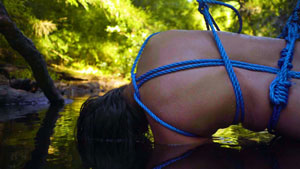8.26.24 — The Nature of Desire
Is there something queer about nature? I might not have said so, but Wave Hill’s Glyndor Gallery thinks otherwise, with “Perfect Trouble: Queering Natureculture,” through August 11. My walks around New York City have been rich again this summer, so allow me one last review on just that (and apologies for a late report, but I was unable to make it to this show until its closing week.)
Wave Hill could be the ultimate hybrid of nature and culture—with its stately galleries, lush grass, meticulously tended botanic gardens, and gorgeous views of the Palisades across the Hudson. Even a fine exhibition is at most an excuse to return in summer. The eight artists themselves seem happy enough to settle for nature’s richness and a bit of art. They cannot define gender or untangle its meanings.  They do not even try to disentangle the natural and cultural aspects of landscape. They show just enough of themselves to make things queer and strange.
They do not even try to disentangle the natural and cultural aspects of landscape. They show just enough of themselves to make things queer and strange.
Wave Hill is more likely to warn of climate change or to celebrate nature than to unsettle its terms. Yet in truth nature in art has always been gendered—and that gender, more often than not, has been female. It contrasts with civilization as men define it and know it. Any number of female nudes have found themselves lying outdoors for the likes of Titian—or falling for its temptations with an apple and a snake. In one tale, Danaë’s father did his best to shield her from a lustful Zeus by confining her indoors. Do not be surprised if the god comes in through the window as a golden shower.
This time out, artists need gender just to tell them who they are. Culture plays a still larger role for Katherine Sepúlveda and Roger Ferney-Cortés, in separate shows in the sunroom. Theirs is the immigrant experience, the latter a Colombian’s with street carts for popsicles. Sepúlveda fills her Halloween House with a chaos of Catholic collectibles. She just has a little trouble deciding whether to exclude visitors, which she does, or, as wall text has it, to invite them in. But then the galleries will be long closed by Thanksgiving.
“Perfect Trouble” is more welcoming, because who can escape desire? Last year at the New Museum, Pepón Osorio pushed an installation like Sepúlveda’s to the edge of a crime scene and the scale of a community. Here the markers are less obvious, but the focus is on sex. That dual impulse, to gender and reticence, helps rescue from the tendentious a motley collection of art. Christopher Udemezue offers hints of people and landscape in close up, in photos and in spooky reds. Others, though, play down a stereotypically gay esthetic.
Sofia Moreno goes so far as to make fun of it. Her self-portrait in colored pencil shares a pink room with grinning demons, and all seem to be having an equally good time. She also adds clay to fabric, for what might be clothing or what it cannot hide. The gendered body may or may not appear for Diana Sofia Lozano, in the thick paint of her Blueberry Dreams, while Erin Johnson takes her video to Huntington Gardens in Pasadena and its scholarly pursuits. One learns only later of Rachel Carson’s letters to her female lover. Like Carson herself, they evoke the wonders of nature all the same.
Rachel Youn takes a step back from nature and the human alike, leaving wide open just what to desire. Artificial plants bob rhythmically up and down, and one may remember their loud, mechanical rhythms as much as their orchid purple. Other artists do rely on bare flesh for a touch of nature. Young Joon Kwak speaks of the Aggregate Body, in a wall of fragmentary photos. Seba Calfuqueo unites nature and culture with a Liquid Being, face down in sunlit grass and water. In a photo, she has lost her head but taken in its place a misty mountain peak and clouds.
Who needs earthly desires anyway when you can have goddesses and gods? Two in Indian jewelry share a swing for Pyaari Azaadi, not quite innocent and not quite making love. The artist, born in Bombay, describes herself as BIPOC, or bisexual and a person of color. The others may not be so blatantly hyphenated, but they might wish they were. They are, after all, hyphenating gender, nature, and culture. As Ruben Natal-San Miguel puts it, in portrait photos of the Bronx community up at Wave Hill House, Nature Finds a Way.